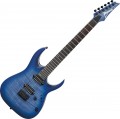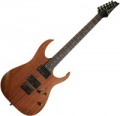Pickguard
The presence of a protective lining (pickguard) on the body of the guitar.
Such an overlay is located on the upper deck, most often made of durable plastic and differs markedly in colour, due to which it is clearly visible. Its main purpose is to protect the soundboard surface from pick strikes (for example, when playing with dynamic fighting), which could damage the varnished wooden surface. The specific shape and size of the fingerboard may vary, but anyway, it covers at least the surface below the strings (when looking at the guitar in the working position), and sometimes under the strings and even above them.
Body top
The material from which the soundboard cover is made is an additional overlay on the upper soundboard, which primarily plays a decorative role and gives the instrument a pleasant appearance. Do not confuse such a cover with a protective overlay (see above about it). And in semi-acoustic instruments with a hollow body (see "Type"), this paragraph may indicate the material of the upper soundboard, and a separate cover as such may be absent.
In general, the value of this parameter is similar to the material of the body (see above) — adjusted for the fact that the deck cover also directly determines the appearance of the electric guitar, and in semi-acoustic models it affects the sound more than the rest of the body. However, the main criterion for choosing this parameter may well be the aesthetic preferences of the musician.
Bridge
The type of bridge provided in the construction of the guitar.
The bridge is often referred to as the part used to secure the strings to the body, but this is not entirely true. There are many models where the bridge plays only the role of a nut (limits the length of the scale), and the string is fixed in a separate device (stop bar) or even in the guitar body, through the method (see below).
All modern breeches can be divided into two main categories. The first is
fixed, in which the strings are fixed, and the tightening during the game can only be performed with the left hand on the fretboard. They somewhat limit the set of techniques available to the musician, but they are inexpensive, compact and do not complicate the tuning of the guitar. The second variety is
tremolo("machines"), which have a lever under the guitarist's right hand, allow you to change the tension of all the strings at once and achieve interesting effects that are not available with a conventional tightening. The disadvantages of "machines" are the opposite of the advantages of "fixes": tremolo bridges are more expensive, often cumbersome, with frequent use they can quickly detun the instrument, and tuning is often quite difficult, requiring specific skills and tools. Note that tremolo machines are used only in electric and semi-acoustic guitars, bass guitars are equipped only with fixed tailpieces.
The main
...types of bridges found in modern electric guitars are as follows:
— Fixed. This designation is used for all fixed breeches other than the popular varieties described below.
— Hardtail (fixed). A distinctive feature of "hardtails" is a metal plate that plays the role of the basis for other mechanics. Such a plate is installed on the top deck; it is bent up from the far side (from the fretboard), and the saddles for the strings are attached simultaneously to the base and to the bent part. The fastening of the strings is often done through. This type of bridge allows you to individually adjust for each string not only the length of the scale, but also the height above the fretboard.
— Tune-o-Matic (fixed). Bridge in the form of a plank, on which saddles for strings are fixed. In this case, the strings can be attached to the body of the guitar (through method), to a separate stop bar or in the holes on the bridge itself (however, the latter is rare). Tune-o-Matic allows you to individually adjust the scale for each string, however, the height above the neck is changed only by changing the height and inclination of the bar (for this, an adjustment screw is provided at each end of the bar).
— Tremolo. Tremolo machines that do not belong to any of the varieties described below; this option is also indicated in cases where the manufacturer, for some reason, did not specify the specific type of "car". This category includes mechanisms that are quite diverse in design and functionality, so the features of such a bridge in each case should be specified separately.
— Vintage Tremolo. One of the first varieties of tremolo machines, developed by Fender. Externally, such a device looks like the Hardtail described above, supplemented by a movable (swivel) mount and a lever for adjusting the tension; fastening strings — most often through. Keep in mind that Vintage Tremolo's are designed primarily for downtuning; it is possible to raise the system with the help of such a machine only slightly, and then this will require certain tricks. Another drawback is that heavy use of the tremolo arm detunes the guitar quite quickly — especially if the player has neglected the tuning rules, which, although not difficult for Vintage Tremolo, are quite specific. On the other hand, “vintages” are inexpensive, and you can compensate for the mentioned drawback, for example, by using a top lock. The classic "vintage" is attached to the body with six screws, but there are also twin-screw versions — they are simpler and at the same time keep the system longer with active use.
— Wilkinson (tremolo). A further development of the design of the Vintage Tremolo described above. One of the key differences of the "Wilkinson" is that the strings in it are held on the bridge itself, and not on the body of the guitar. Because of this, this type of breeches stay in tune much better than the original "vintage" breeches. In addition, the lever in such "machines" is attached without thread, so that the likelihood of backlash is reduced to zero. On the other hand, Wilkinson bridges are noticeably more expensive, and their main function is to lower the tuning (although, again, with some tricks, a slight increase is possible).
— Bigsby (tremolo). Another representative of the "timeless classic", perhaps the first tremolo system in the world. Today it is used mainly on vintage-style guitars; particularly well suited for semi-acoustic instruments, as attached to the end of the guitar, not to the thin top, and does not place heavy loads on the soundboard. A distinctive feature of the Bigsby is that as a stop bar to which the strings are attached, such machines use a round rod that rotates from the movement of the lever and thus changes the tension of the strings. Due to this, such bridges have a number of advantages: they can work both down and up, they are easy to tune and keep the system well and respond to the slightest movement of the lever, allowing the musician to control the sound very precisely. In addition, Bigsby systems have a stylish appearance. On the other hand, they are quite massive and bulky, expensive, and the adjustment range is relatively small (smaller than that of the same Floyd Rose).
— Floyd Rose (tremolo). One of the most popular tremolo systems used by professional musicians. It is similar in design to the Vintage Tremolo, in particular, it is also mounted on two bolts and has a spring that compensates for the tension of the strings. However, the design of the Floyd Rose allows the action to be changed both downwards and upwards (increasing the tension), providing possibilities that are not available with "vintage" and similar systems; and similar machines differ from Bigsby in a wider range of adjustment. Note that the design of instruments with such bridges usually includes a top-lock — a device that clamps the strings on the fingerboard at the nut. Thanks to this, the “floyd roses” perfectly keep the system when actively working with the lever. All this led to the popularity of these systems among guitarists. On the other hand, setting up and caring for such breeches is a very difficult, painstaking and delicate matter. So, for setting strings and tuning, a whole set of keys may be required; when a string breaks, the system “floats”, and replacing a damaged string is inevitably associated with retuning the entire guitar; moreover, the system can go astray even from inaccurate movement of the instrument or a strong blow with the palm when muting the strings. Therefore, Floyd Rose type machines are mainly recommended for advanced guitarists with experience in handling electric guitars. And even professional musicians sometimes prefer to go to the master, rather than messing around with the service themselves.
— Kahler (tremolo). A system similar to Floyd Rose, but without springs and fixed directly to the body, usually with 4 screws. This allows you to slightly increase the sustain (due to improved contact of the strings with the body). The rest of the advantages and disadvantages are in most cases the same as Floyd Rose. However, high-quality solutions are also produced under the Kahler brand, which are not cheap, but have an improved design and are devoid of a number of disadvantages — in particular, such models are insensitive to changes in the position of the instrument and sharp muting of the strings with the palm of your hand.
— Zero Resistance (tremolo). Another improved version of the Floyd Rose described above, which is distinguished by the presence of a blocker — a device that rigidly fixes the bridge. Thanks to this, the system does not “float” when the string breaks, and the tuning of the guitar is noticeably simplified compared to the original Floyd Rose. The disadvantage of ZR is traditional — a high price.
It is worth noting that the above list does not include specific brands of bridges, but only their general types; within the same type, there may be models that differ somewhat in design and functionality.Neck profile
Profile of a fretboard mounted on an electric guitar.
The profile of the neck is called its shape in section, more precisely, the shape of the back of the neck. This parameter practically does not affect the sound of the guitar, but it directly affects the convenience of playing. Ideally, the neck should “fill” the hand, but not be too large — otherwise it will not be possible to clasp it to the right extent.
Profiles are denoted by the letters C, D, V and U — depending on which letter the neck resembles in the section. Profile D is the flattest, C is slightly more convex, with almost uniform curvature along the entire length, U is more voluminous, with a wider profile in the area of the lining, and the V profile in its classic form has the form of an angle with a rounded top. There are also modifications of these options — for example, "thin", which provides for a reduced profile thickness, or "modern", with slightly improved (theoretically) ergonomics.
The most popular profile types are
C,
U and their "modern" (modern) modifications. The C profile is almost semi-circular, the U profile is more voluminous, at the fingerboard its edges are almost parallel and only closer to the back of the neck are sharply rounded. The terms
modern C and
modern U refer to various improved versions of these profiles, their f
...orm may be different.
In fact, the choice of neck profile depends solely on the guitarist's personal preferences, the characteristics of his hands and his preferred playing technique. Thus, there is no "perfect" profile shape — in each case, the optimal choice will be different. The perfect option is to try several types of profile "live", decide which one will be more convenient, and choose an instrument with a neck of the same or similar profile shape.
